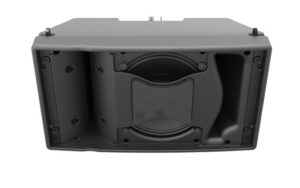#nexosound
#nexolife
Part 3
“It’s a simple but extremely high-value invention. The consequences of this device are fabulous,” says François Deffarges, NEXO’s Director of Engineering Support.
He’s describing the Directivity Phase Device (DPD), the unique feature that sets NEXO’s line array systems apart from the rest. Over the last 20 years, many manufacturers have tried to copy the idea and found themselves on the wrong side of a letter from NEXO’s patent lawyers!
Developed as part of the GEO S8 tangent array programme, the DPD remains an integral component of NEXO’s modern loudspeaker systems. A deceptively simple device, any explanation of its application starts with some digital audio basics.

“All engineers know, if you want to have 20kHz bandwidth, you have to sample at least at twice the frequency,” explains Deffarges. “To reproduce or record 20kHz, you need to sample at least at 40kHz. Today, engineers are using 44.1kHz, 48kHz, even 96kHz, in order to extend the frequency response above 20kHz. With line arrays, our ambition is to create a continuous line: we want sources that behave as one, not interfere with each other. Coupled direct radiation drivers will interfere when the distance between them exceeds half a wavelength, which sets a strong constraint on the crossover frequency to high frequency drivers (these are very likely to distort below 1 kHz).
“In the beginning, we applied the DPD to the GEO S8 which was using an 8” driver, measuring more or less 20cm. With my speakers spaced 20 cm apart, which is half a wavelength of 40 cm, it means that I can use my 8” drivers up to 850Hz, but above that they are going to interfere. So I have to switch to the HF driver, the waveguide. The 8” will go to 850Hz and further, but the problem lies with HF drivers, which distort massively in the lower range. When you use HF drivers, especially small ones, at very low frequencies, they create massive distortion.
“The DPD is a separator. Placing the DPD in front of the membrane splits the radiating surface in two. So instead of having one 8” driver, I have two physical sources that are spaced 4” apart rather than 8” apart. Dividing by 2 the acoustic distance between coupled devices means the crossover point to the high frequency driver can be increased by one octave.
“Because the spacing is 4”, 10cm instead of 20cm, I can use my 8” driver beyond 850Hz, I can use it all the way up to 1.7kHz. So my crossover point at HF is 1.7kHz, (in fact, that was the crossover point of GEO S8) and there are benefits; these are very important frequencies, and the human ear is very sensitive to them. Consequently, the device is massively reducing the distortion: 850-1.7kHz, I have divided the distortion by a factor of 10.

“We’re also increasing the efficiency of the acoustic response around 1.5kHz, because it behaves like some kind of acoustic waveguide on top of the 8” driver. For the user that means increased power and less distortion in that 1-2kHz range.
“The DPD is now implemented on all NEXO cabinets, except for STM Series, which use flat membranes for the MF. We needed to have flat surfaces on STM because of the symmetrical architecture, so that we didn’t create differential on the HF. On M46, we have 4x HF drivers; we have over-dimensioned the HF so that low-frequency crossover point could be lower. (800Hz on the STM).
“On the current GEO M series of line arrays, the DPD scales up as you go through 6”, 10” and 12” drivers. On the GEO M12, for example, the lowest crossover point without the DPD is 550Hz – there is not a single HF that accepts 550Hz, it is too low – with the DPD, we can crossover at 1.1kHz. Linear scaling allows you to gain an octave by multiplying by 2 the crossover points: the smaller the driver, the higher the crossover point.”
What does this mean for the user? No distortion. The GEO M (and GEO S12) systems are extremely clear in the mid-frequencies range, not aggressive at all. By reducing the distortion, the system is more transparent, more natural, and offers more headroom. Other manufacturers, without the advantage of the DPD, have either to use lower frequency crossover points from LF to HF drivers giving them less power, or some have interference between the mid-frequencies so the response over the coverage area is inconsistent.
“The DPD is a very simple idea. It’s like inventing over-sampling; 96kHz vs 48kHz. The benefit is unbelievable, from the user’s point of view. If NEXO had not patented the DPD, it would be in every line array on the market today.”
















































